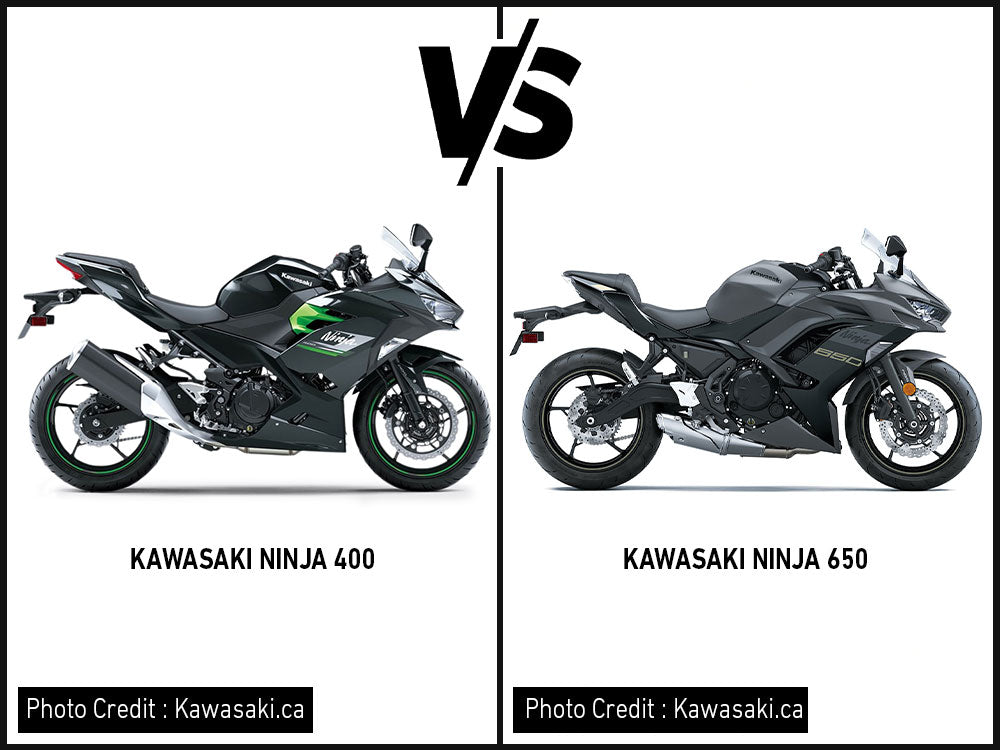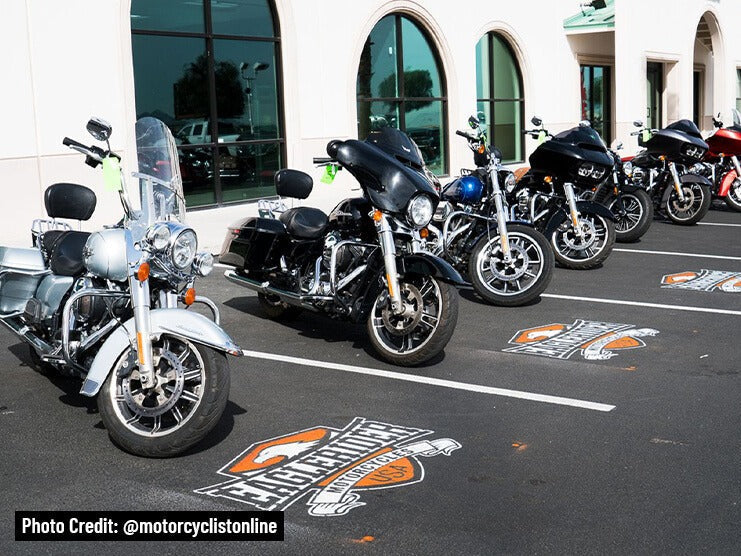Table of Content
The Kawasaki Ninja 400 and Ninja 650 are both well-known sports motorbikes constructed by the Kawasaki Motorcycle and Engine Company. The Ninja 400 and 650 are designed for both beginners and experienced riders as the power produced by both Ninja models is neither too much for beginners nor too low for experts. The Kawasaki Ninja 400 and Ninja 650 offer a comfortable and smooth riding experience with style. The best thing about the Kawasaki Ninja 400 and 650 is that both of them have affordable prices.
In a market full of adventure motorbikes, the Kawasaki Ninja 400 and Ninja 650 helped introduce sports motorcycles to the market. With the introduction of these innovatively designed sports motorcycles, the line between sports bikes and tourers became blurred.
Continue reading this article to know more about the specs, performance, features, pros, and cons of the Kawasaki Ninja 400 and 650.
1. Kawasaki Ninja 400 VS Ninja 650
The notable differences between the Kawasaki Ninja 400 and Ninja 650 are found in their modern features, engine size, front brake, dimensions, and weight.
The Ninja 400 is equipped with a 399 cc engine which makes it highly suitable for beginners. It also offers smooth riding, low weight, easy handling, and comfortable ergonomics.
The Kawasaki Ninja 650 is suitable for experienced riders and beginners who are trained enough to switch to their second motorbike. With a 649 cc engine, middleweight package, smooth handling, and manageable power and speed, the Ninja 650 is faster than the Ninja 400.
2. Kawasaki Ninja 400 at a First Glance

Kawasaki has ruled the beginner motorbike market for more than three decades now. With the introduction of the Kawasaki Ninja 250R in 1986, the Kawasaki became prominent in the low-powered motorcycle range. In 2012, Kawasaki then introduced the Ninja 300. In 2018, Kawasaki decided to launch the Ninja 400 because the Ninja 300 failed to comply with emission standards. After discontinuing the Ninja 300, the Ninja 400 became one of the best motorbikes for beginners. The Ninja 400 also has a variant with an ABS installed.
3. Kawasaki Ninja 650 at a First Glance

The Kawasaki Ninja 650 was introduced in 2006. This motorcycle is good for both daily commutes and touring. The Ninja 650 is powered by a 649 cc engine with modern looks and features. The low seat height and low center of gravity give the Ninja 650 comfortable riding ergonomics. Being built with a lighter frame helped reduce the overall weight of the Ninja 650 which enabled better handling.
4. Kawasaki Ninja 400 VS Ninja 650: Detailed Comparison
4.1 Kawasaki Ninja 400 VS Ninja 650: Engine and Performance
The Kawasaki Ninja 400 is equipped with a 399 cc engine, while the Ninja 650 is equipped with a 649 cc engine. The engines are kept cool thanks to a liquid-cooling system. The Ninja 400 and Ninja 650’s engines are four-stroke, parallel twin, DOHC engines. The six-speed transmission allows the Ninja 400 and 650 to smoothly shift gears. The ignition types and fuel systems are the same in both the Ninja 400 and Ninja 650.
The Kawasaki Ninja 650 can reach a top speed of approximately 130 mph. Whereas, the Kawasaki Ninja 400 can attain a top speed of 116.7 mph. This could vary if a beginner rides either the Ninja 400 or Ninja 650.
The Kawasaki Ninja 400’s engine is capable of producing a torque of 37.96 Nm at 8,000 rpm and a horsepower of 49 hp at 10,500 rpm. The Ninja 650 can produce a 63.72 Nm torque at 6,700 rpm and a horsepower of 67 hp at 8,000 rpm.
4.2 Kawasaki Ninja 400 VS Ninja 650: Styling
The Kawasaki Ninja 400 and Ninja 650 are stylishly designed with sporty looks. The full fairing body of both motorcycles gives off an aggressive look. The Ninja 400 and Ninja 650 are not lacking in laid-back ergonomics. The Ninja 650 received styling upgrades in 2012 when the chassis was redesigned. The Ninja 650 was upgraded with an improved instrument panel, a two-piece saddle for both the rider and passenger and extended bars.
The Ninja 400 and Ninja 650 are available in attractive color schemes. The 2022 Ninja 400 is available in two dual-tone colors, including metallic carbon gray with metallic flat spark black colors and metallic matte twilight blue with metallic graphite gray colors. The 2022 Ninja 650 comes in metallic matte graphene steel gray color and a dual-tone pearl robotic white with metallic carbon gray colors.
4.3 Kawasaki Ninja 400 VS Ninja 650: Weight and Seat Height
The Kawasaki Ninja 400 has a seat height of 30.9 inches which makes this motorbike an easy ride for shorter riders. The Ninja 650 has a seat height of 31.1 inches. The lower seat height, comfortable legroom, and upright back position of the Ninja 400 and Ninja 650 offer comfortable riding ergonomics. Also, the Ninja 400 weighs only 166 kg which makes it easier to handle, has great stability, and can clear corners smoothly. The Ninja 650 is heavier than its counterpart, weighing about 192 kg.
4.4 Kawasaki Ninja 400 VS Ninja 650: Technology and Features
The Kawasaki Ninja 650 is also equipped with dual throttle valves. The Ninja 400 comes with the Ergo-Fit® feature to make the riding experience more comfortable for taller riders.
Both the Kawasaki Ninja 400 and 650 are equipped with the latest technologies, including the Economical Riding Experience and Assist and Slipper Clutch. The Economical Riding Experience is a modern feature in the Ninja 400 and 650 motorbikes that electronically monitors the motorbikes’ fuel consumption. There are certain riding conditions, a specific speed, and gear level that enables eco mode, which appears on the Ninja 400 and 650’s indicator screens. It means that the motorcycle is consuming less fuel because the right conditions are met.
Both the Kawasaki Ninja 400 and 650 are equipped with ABS. The ABS allows better handling and stability when turning corners.
5. Kawasaki Ninja 400 VS Ninja 650: Detailed Specs Comparison
5.1 Identification
| Motorcycle | Ninja 400 | Ninja 650 |
|---|---|---|
| Maker | Kawasaki | |
| Model | Ninja 400 | Ninja 650 |
| Model Year | 2022 | |
| Production | 2018 - Present | 2016 – Present |
| Motorcycle Type | Sports Bike | |
| Color | Metallic Carbon Gray/Metallic Flat Spark Black and Metallic Matte Twilight Blue/Metallic Graphite Gray | Metallic Matte Graphenesteel Gray and Pearl Robotic White/Metallic Carbon Gray |
| Price | With ABS ($5,599 - $5,799) | With ABS ($8,299 - $8,499) |
| Without ABS ($5,199 to $5,399) | Without ABS ($7,899 - $8,099) | |
5.2 Engine and Transmission
Motorcycle |
Ninja 400 |
Ninja 650 |
|---|---|---|
Engine Type |
Parallel-Twin, Four-Stroke |
|
Displacement |
399 cc |
649 cc |
Cooling |
Liquid-Cooled |
|
Compression Ratio |
11.5:1 |
10.8:1 |
Bore |
70 mm |
83 mm |
Stroke |
51.8 mm |
60 mm |
Valve Train |
DOHC |
|
Starting |
TCBI with Digital Advance |
|
Fuel System |
DFI® with dual 32mm throttle bodies |
DFI® with dual 36mm Keihin throttle bodies |
Fuel Type |
Petrol |
|
Clutch |
Assist and Slipper Clutch |
Wet Sump |
Final Drive |
Sealed Chain |
|
Gearbox |
Six-Speed |
|
5.3 Performance
Motorcycle |
Ninja 400 |
Ninja 650 |
|---|---|---|
Torque |
37 Nm at 8,000 rpm |
64 Nm at 6,700 rpm |
Power |
44.7 hp at 10,000 |
67.3 hp at 8,000 rpm |
Fuel Economy/ Mileage |
58.8 mpg |
70.56 mpg |
Top Speed |
116.7 mph |
130 mph |
5.4 Dimensions and Weight
Motorcycle |
Ninja 400 |
Ninja 650 |
|---|---|---|
Width |
28 in |
29.1 in |
Length |
78.3 in |
80.9 in |
Height |
44.1 in |
45.1 in |
Curb Weight |
166 kg |
192.05 kg |
Saddle Height |
30.9 in |
31.1 in |
Ground Clearance |
5.5 in |
5.1 in |
Fuel Capacity |
3.7 gal |
4 gal |
Wheelbase |
53.9 in |
55.5 in |
Reserve Fuel Capacity |
2.8 L |
2.3 L |
Rake |
24.7° |
24.0° |
Trail |
3.6 in |
3.9 in |
5.5 Chassis
| Motorcycle | Ninja 400 | Ninja 650 |
|---|---|---|
| Frame | Trellis, high-tensile steel | |
| Brakes | ||
|---|---|---|
| ABS | Dual Channel | |
| Front | Single Disc | Dual Discs |
| Type | Semi-Floating Petal-Type | Petal-Type |
| Size | 310 mm | 300 mm |
| Calipers | Two-Piston Calipers | |
| Rear | Single Disc | |
| Type | Petal-Type | |
| Size | 220 mm | |
| Caliper | Single-Piston Caliper | |
| Suspensions | ||
|---|---|---|
| Front | Hydraulic Telescopic Fork | |
| Size | 41 mm | |
| Wheel Travel | 4.7 in | 4.9 in |
| Rear | Horizontal back-link with adjustable spring preload | |
| Wheel Travel | 5.1 in | |
| Tires | ||
|---|---|---|
| Front | 110/70-17 | 120/70x17 |
| Rear | 150/70-17 | 160/60x17 |
5.6 Warranty
Motorcycle |
Ninja 400 |
Ninja 600 |
|---|---|---|
Warranty |
One year |
|
5.7 Modern Technology and Features
Motorcycle |
Ninja 400 |
Ninja 600 |
|---|---|---|
Ergo-Fit |
Yes |
No |
Dual Throttle Valves |
No |
Yes |
Daytime Running Lights |
Yes |
|
Economical Riding Indicator |
Yes |
|
Horizontal Back-link Rear Suspension |
Yes |
|
Odometer |
Yes, Digital |
|
ABS |
Yes |
|
Speedometer |
Yes, Digital |
|
Fuel Gauge |
Yes |
|
Assist and Slipper Clutch |
Yes |
|
Pillion Seat |
Yes |
|
Pillion Grabrail |
Yes |
|
Pillion Footrest |
Yes |
|
Low Oil Indicator |
Yes |
|
Killswitch |
Yes |
|
Traction Control |
No |
|
6. Pros and Cons of Kawasaki Ninja 400 Vs Ninja 650
6.1 Ninja 400 Pros
The Ninja 400 are ideal for beginners because of its low-powered engine and good handling. The Ninja 400 is best for daily commutes and offers an easy ride while riding on busy roads. This motorbike has better acceleration and braking because of the low-powered engine, lighter weight, and ABS. The Ninja 400 has more color schemes than the Ninja 650.
6.2 Ninja 400 Cons
Though the Ninja 400 is meant for beginners, this motorbike still lacks safety features like traction control or rider modes. The Ninja 400 is not suited for heavier and taller riders because of its lighter weight. The Ninja 400 is not easy to handle when riding in windy conditions. The passenger seat on the Ninja 400 is too thin and uncomfortable.
6.3 Ninja 650 Pros
The improved features and parts of the Ninja 650 make it an ideal choice for experienced riders. With improved suspensions and being able to turn corners better, the Ninja 650 offers great handling at high and low speeds. The Ninja 650 also can be used for touring.
6.4 Ninja 650 Cons
The old Ninja 650 models do not come with passenger handrails despite higher passenger seat adjustment. The earlier Ninja 650 models came with upright handlebars which are not compatible with the aggressive riding position.
7. Kawasaki Ninja 400 vs Ninja 650: The Better Beginner Sports Motorcycle
Motorbikes with low-powered engines are recommended for beginners. The Ninja 400 is the better beginner bike between the Ninja 400 and Ninja 650. However, it is not a hard-and-fast rule. In the same way, the Ninja 650 is not particularly designed for expert riders. It depends on various factors like rider weight, comfort level, why you need to buy a new motorcycle, and how much money you are willing to spend. A beginner can ride the Ninja 650 with ease if he or she knows the basics of shifting gears and releasing the clutch.
8. Takeaway
Both the Ninja 400 and Ninja 650 motorcycles are built with good qualities and specs. The Ninja 400 is ideal for daily commutes and traveling through city streets. Whereas the Ninja 650 is suitable for highways and cruising. In the sports bike range, the Kawasaki Ninja 400 and Ninja 650 are well-known for their sporty looks. The differences between the Ninja 400 and Ninja 650 are few. Both motorbikes are equally reliable if you are a beginner looking for your first motorbike.
Both the Kawasaki Ninja 400 and Ninja 650 are eligible for light touring. With the help of the aftermarket parts, you can enhance the storage to carry more luggage while you go on tour. There are several LUGGAGE options available at Viking Bags that include SADDLEBAGS, TAIL BAGS, BACKPACKS, and TANK BAGS.













Leave a comment
All comments are moderated before being published.
This site is protected by hCaptcha and the hCaptcha Privacy Policy and Terms of Service apply.